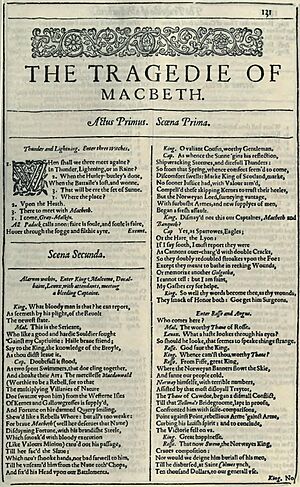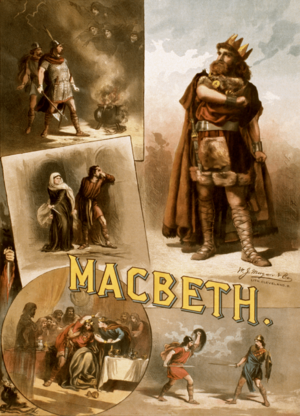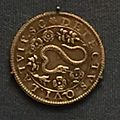Macbeth facts for kids

Title page of the part in the First Folio.
|
|
| Author | William Shakespeare |
|---|---|
| Country | London, England |
| Language | English |
| Genre | Shakespearean tragedy Tragedy |
| Set in | Scotland and England (Act IV, Scene III) |
| Publisher | Edward Blount and William Jaggard |
|
Publication date
|
1623 |
| Text | The Tragedie of Macbeth at Wikisource |
Macbeth (full title The Tragedie of Macbeth) is a famous play written by William Shakespeare. It is a tragedy, which means it has a sad or terrible ending. People think it was first performed around 1606.
The play shows how wanting too much power can badly affect people. It explores the minds of those who try to grab power. Macbeth also shows Shakespeare's connection with King James I, who supported Shakespeare's acting group. The play was first printed in a collection called the First Folio in 1623. It is Shakespeare's shortest tragedy.
Contents
What Happens in Macbeth?
A Prophecy and a Terrible Choice
The story begins in Scotland. A brave general named Macbeth meets three mysterious witches. They tell him that he will one day become King of Scotland.
This prediction fills Macbeth with a strong desire for power. His wife, Lady Macbeth, encourages him to act on it. Together, they decide to kill King Duncan, who is the current king. After the murder, Macbeth takes the Scottish throne for himself.
Guilt, Fear, and More Bad Deeds
After becoming king, Macbeth feels a lot of guilt and fear. He becomes very suspicious of everyone around him. To protect his new power, he starts to commit more terrible acts. He orders more murders to get rid of anyone he sees as a threat.
Macbeth quickly becomes a very unfair and cruel ruler. His actions lead to a lot of violence and eventually a civil war in Scotland. This path of violence and fear drives both Macbeth and Lady Macbeth towards madness and their downfall.
Where Did the Story Come From?
Shakespeare got the idea for Macbeth from an old history book. This book was called Holinshed's Chronicles (1587). It told stories about the history of England, Scotland, and Ireland.
The play's events are different from the real history of Macbeth, King of Scotland. However, the play does include characters like Macduff and Duncan, who were real historical figures. Some people also connect the play's themes to the Gunpowder Plot of 1605. This was a plan to blow up the English Parliament and King James I.
The "Scottish Play" Superstition
In the world of theatre, some people believe that Macbeth is a cursed play. Because of this, they do not say its name out loud when they are backstage in a theatre. Instead, they call it "The Scottish Play" to avoid bad luck.
Despite this superstition, Macbeth is a very popular play. Many famous actors have wanted to play the roles of Macbeth and Lady Macbeth. The story has also been made into movies, TV shows, operas, and even comic books.
Who are the Main Characters?
- Duncan – the King of Scotland
- Malcolm – Duncan's older son
- Donalbain – Duncan's younger son
- Macbeth – a general in King Duncan's army; he becomes Thane of Glamis, then Thane of Cawdor, and later King of Scotland
- Lady Macbeth – Macbeth's wife, who becomes Queen of Scotland
- Banquo – Macbeth's friend and a general in the army
- Fleance – Banquo's son
- Macduff – Thane of Fife
- Lady Macduff – Macduff's wife
- Macduff's son
- Ross, Lennox, Angus, Menteith, Caithness – Scottish noblemen (thanes)
- Siward – a general leading the English forces
- Young Siward – Siward's son
- Seyton – Macbeth's personal assistant
- Hecate – the queen of the witches
- Three Witches
- Captain – in the Scottish army
- Murderers – hired by Macbeth
- Third Murderer
- Porter – the gatekeeper at Macbeth's castle
- Doctor – Lady Macbeth's doctor
- Doctor – a doctor at the English court
- Gentlewoman – Lady Macbeth's helper
- Lord – a nobleman who opposes Macbeth
- First Apparition – a vision of an armed head
- Second Apparition – a vision of a bloody child
- Third Apparition – a vision of a crowned child
- Attendants, Messengers, Servants, Soldiers
Images for kids
-
Macbeth consulting the Vision of the Armed Head by Johann Heinrich Füssli
-
Lady Macbeth sleepwalking by Johann Heinrich Füssli
-
Macbeth and Banquo with the Witches by Henry Fuseli
-
A picture of William Charles Macready playing Macbeth in the mid-19th century
-
A photograph of Ellen Terry as Lady Macbeth in an 1888 show
-
Jack Carter and Edna Thomas in the Voodoo Macbeth play from 1936
See also
 In Spanish: Macbeth para niños
In Spanish: Macbeth para niños












